Fluorescent-labeled proteins can be robust tools for the detection of antibody screening and CAR expression using flow cytometry. But it is difficult to develop high-quality fluorescent-labeled proteins, and there are very few products available in the market.
ACROBiosystems is a reliable partner to offer antigens for biologic drug discovery and development, developing a unique collection of PE-labeled and FITC-labeled proteins by using the chemical labeling technique developed in-house.
These fluorescent-labeled proteins are exclusively ideal for flow cytometry-based assays, for example, detecting cell-based ligand binding assays and anti-CD19 CAR expression.
Features and benefits
- Identical binding capacity before and after conjugation
- Bioactivity verified by flow cytometry and protocol offered
- High batch-to-batch consistency
Case studies
Evaluation of CAR expression by flow cytometry
FACS analysis of anti-CD19 CAR expression
293 cells were transfected with anti-CD19-scFv and RFP tag. 2e5 of the cells were stained with FITC-Labeled Human CD19 (20-291), Fc Tag (Cat. No. CD9-HF251, 10 μg/mL) and FITC-labeled protein control. Non-transfected 293 cells and FITC-labeled protein control were used as negative control. RFP was used to evaluate CAR (anti-CD19-scFv) expression and FITC was used to evaluate the binding activity of FITC-Labeled Human CD19 (20-291), Fc Tag (Cat. No. CD9-HF251) (QC tested). Image Credit: ACROBiosystems
Flow cytometry-based ligand binding assay
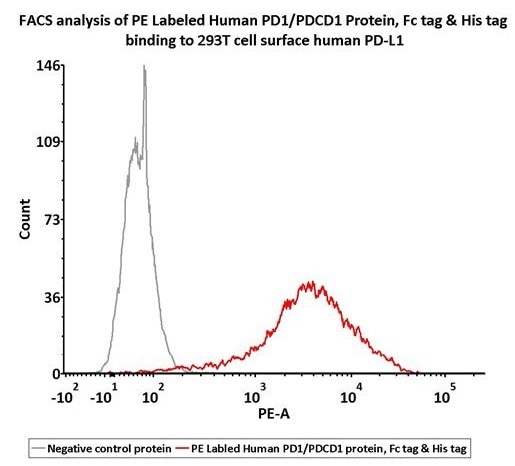
Flow Cytometry assay shows that PE-Labeled Human PD-1, Fc Tag, His Tag (recommended for neutralizing assay) (Cat. No. PD1-HP2F2) can bind to 293T cells overexpressing human PD-L1. 1 μL stock solution per million cells (QC tested). Image Credit: ACROBiosystems
Flow cytometry-based neutralizing antibody screening assay
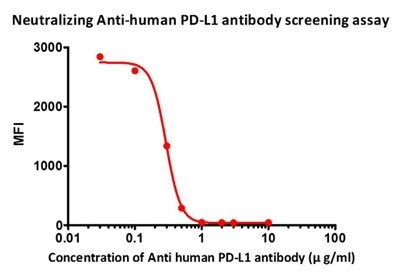
FACS analysis shows that the binding of PE-Labeled Human PD-1, Fc Tag, His Tag (recommended for neutralizing assay) (Cat.No.PD1-HP2F2) to 293T overexpressing PD-L1 was inhibited by increasing concentration of neutralizing antihuman PD-L1 antibody. The IC50 is 0.29 μg/mL (QC tested). Image Credit: ACROBiosystems
High batch-to-batch consistency
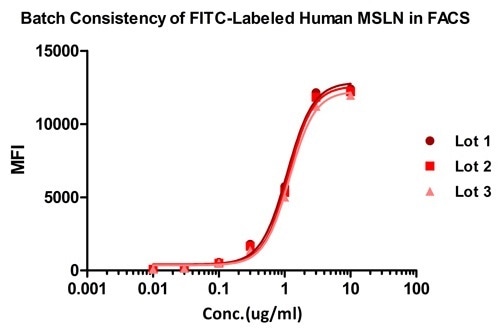
Binding activity of three different lots of FITC-labeled Human MSLN, Fc Tag was evaluated in the above FACS analysis against Anti-MSLN CAR-293 cells. The result shows very high batch-to-batch consistency. Image Credit: ACROBiosystems
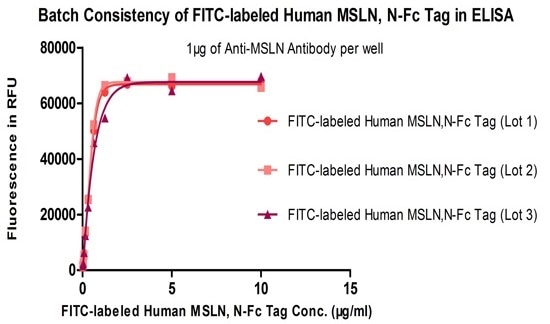
Binding activity of three different lots of FITC-labeled Human MSLN, Fc Tag was evaluated in the above ELISA analysis against Anti-MSLN Antibody. The result shows very high batch-to-batch consistency. Image Credit: ACROBiosystems
Identical binding capacity before and after conjugation
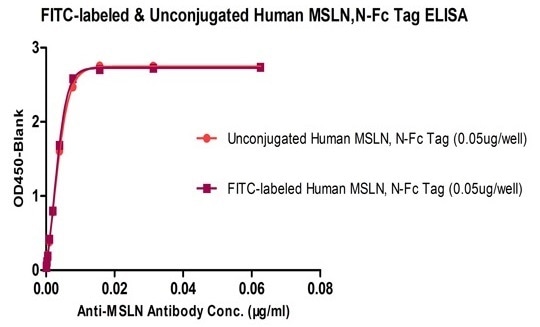
Binding activity of the Human MSLN, Fc Tag before and after FITC labeling was evaluated in the above ELISA analysis. The result shows that FITC-Labeled and Unconjugated Human MSLN, Fc Tag have almost the same level of binding activity. Image Credit: ACROBiosystems
Product list
PE labeled protein
Table 1. Source: ACROBiosystems
| Molecule |
Cat. No. |
Species |
Product Description |
Host |
Structure |
| BCMA |
BCA-
HP2H2 |
Human |
PE-Labeled Human BCMA / TNFRSF17 Protein, His Tag |
HEK293 |
|
| CD19 |
CD9-
HP2H3 |
Human |
PE-Labeled Human CD19 (20-291) Protein, His Tag |
HEK293 |
|
| Mesothelin |
MSN-
HP223 |
Human |
PE-Labeled Human Mesothelin (296-580) |
HEK293 |
|
| PD-1 |
PD1-
HP2F2 |
Human |
PE-Labeled Human PD-1, Fc Tag, His Tag (recommended for neutralizing assay) |
HEK293 |
|
| SIRP alpha |
SIA-
HP252 |
Human |
PE-Labeled Human SIRP alpha, Fc Tag
(recommended for neutralizing assay) |
HEK293 |
|
FITC labeled protein
Table 2. Source: ACROBiosystems
| Molecule |
Cat. No. |
Host |
Product Description |
Structure |
| BCMA |
BCA-HF254 |
HEK293 |
FITC-Labeled Human BCMA / TNFRSF17 Protein, Fc Tag DMF FiledHot |
|
| BCA-HF2H1 |
HEK293 |
FITC-Labeled Human BCMA / TNFRSF17 Protein, His Tag DMF Filed |
|
| BCA-HF2H3 |
HEK293 |
FITC-Labeled Human BCMA / TNFRSF17 Protein, His Tag Star Staining |
|
| CD19 |
CD9-HF251 |
HEK293 |
FITC-Labeled Human CD19 (20-291) Protein,
Fc Tag DMF FiledHot |
|
| CD9-HF2H2 |
HEK293 |
FITC-Labeled Human CD19 (20-291) Protein, His Tag DMF FiledHot |
|
| CD9-HF2H3 |
HEK293 |
FITC-Labeled Human CD19 (20-291) Protein, His Tag Star Staining |
|
Click here to learn about many more FITC labeled proteins.